Supporting guidance for Wild Bird Seed for Farmland Birds
Date published: 19 January, 2022
For recent changes to this guidance, please see the bottom of the page.
To see recent changes to this guidance, please check the bottom of the page
Table of Contents
- Where to locate your wild bird seed mix
- How much to sow
- What to sow
- Corn bunting mixtures
- Establishing the crop
- How to improve the success of this option
- What else benefits from this option?
- Further information
- Recent changes
- Previous versions
- Download guidance
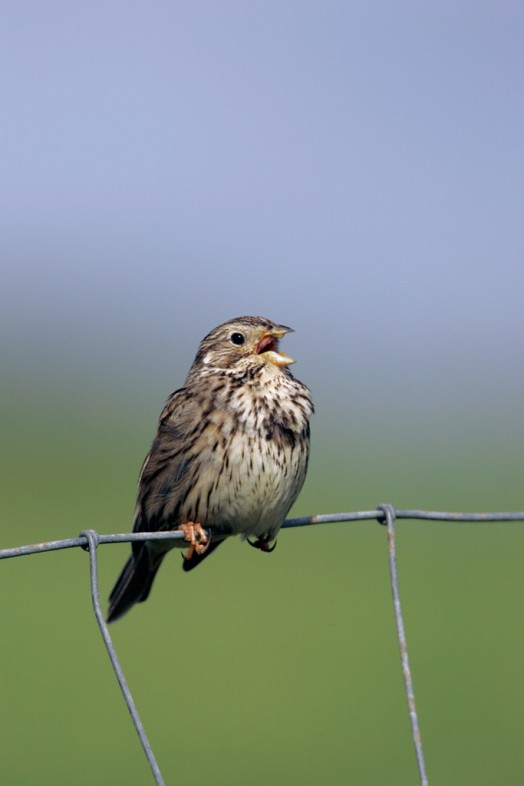
Farmland birds have the following requirements to survive and breed successfully:
- overwinter food and cover
- nesting habitat
- insect food for adults and young
The Wild Bird Seed for Farmland Birds option provides overwinter food and cover for birds throughout winter. It provides some cover for birds during the summer. Not spraying the crop helps to increase the amount of insect food available for adults and chicks.
Species such as corn bunting, tree sparrow and grey partridge can all benefit from this option.
The addition of nectar and pollen producing plants also provides an excellent source of food for pollinating insects such as bees and hoverflies in the summer and autumn. Increased insect abundance can also benefit local bat populations.
Lower inputs and herbicide restrictions also mean that wild bird seed crops can provide good conditions for rare arable plants to re-establish themselves.
All the bird species benefiting from this option feed on seeds, including cereal grain, grass and weed seeds.
Two species, linnet and twite, even feed their chicks on weed seeds or unripe rapeseed while still in the nest. Others feed their chicks on insects and other invertebrates.
Where to locate your wild bird seed mix
Different species benefit from crops grown in slightly different locations. Aim to sow several strips or blocks around the farm, and either target a particular species or provide for several species known to be in the area.
Things to consider:
- crops containing grain that are grown alongside nesting cover such as hedgerows, grass margins or beetle banks benefit grey partridges and yellowhammers
- corn buntings and skylarks prefer open landscapes so establish your crop away from woodlands
- corn buntings like to perch on overhead wires, fences and isolated trees, so establish your crop close to these features
- black grouse will use crops adjacent to moorland
- narrow (20 metre) strips of crop alongside nesting cover, such as grass strips, hedgerows or beetle banks, can provide good brood-rearing cover for species such as grey partridge. Lower seed rates in these areas will encourage a more open habitat
- avoid sowing in shaded areas next to dense woodland where establishment will be difficult and deer and rabbit grazing can be a problem
- cereals will be the main component of the mix – oats, barley and triticale are widely used
- linseed attracts finches
- quinoa produces an abundance of seeds in the early winter
- adding an annual flowering plant such as crimson clover will help to encourage insects for the birds to feed on
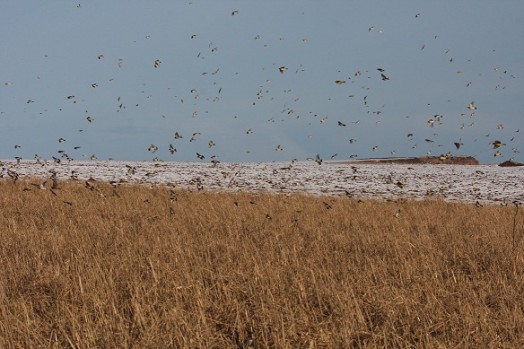
Flock of seed eaters – Credit: Hywel Maggs
How much to sow
Sow about one - two hectares of wild bird seed per 100 hectares, ideally in two to four separate blocks or strips. Each block or strip should be at least six metres wide.
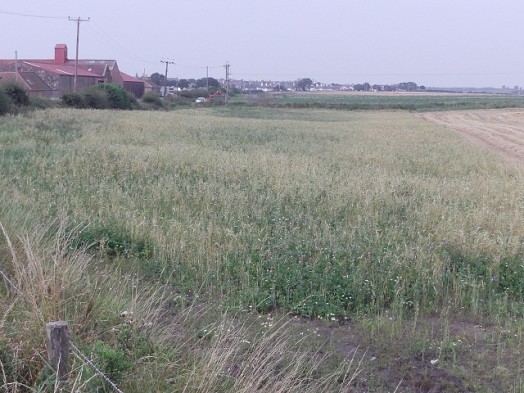
Wild bird seed mix strip next to hedgerow – good for grey partridge and yellowhammer – Credit: Hywel Maggs
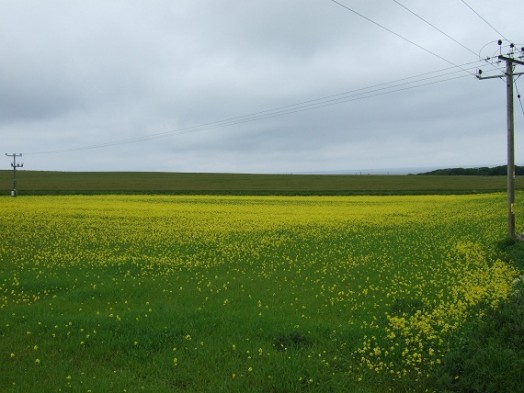
Wild bird seed mix block in open landscape but under wires – good for corn bunting and skylark – Credit: Hywel Maggs
What to sow
- sow a mixture suitable for your farm type and the farmland birds in your area. Cereals will be the major component of the seed mix. Larger birds prefer barley grains and smaller birds prefer oats
- an oil-rich seed produced by plants such as fodder radish, mustard, quinoa or linseed is essential. Small oil-rich seeds are favoured by linnets, goldfinch and twite
- a mix of linseed, triticale, oats and red clover will provide relatively open cover through which birds such as grey partridge can forage
- plants that produce pollen and nectar will encourage pollinating insects such as bumble bees and hoverflies. Red clover, phacelia and borage can all supplement a seed mix to benefit insects
- as the option requires annual sowing, avoid sowing kale because it sets seed in its second year
- avoid using a mix made up with more than 70 per cent (by weight) of a single species
Corn bunting mixtures
- corn buntings need annually-sown, grain-rich mixtures. Mixes that include oats, barley and triticale provide a source of grain throughout the winter
- mixes should also include an annual-seeding brassica such as mustard or rape or, where club root is an issue, linseed. The addition of red clover provides insect habitat and dense cover for these ground nesting birds
- a typical corn bunting one-year mix could include 32 per cent triticale, 31 per cent barley, 31 per cent oats, four per cent per cent brassica or linseed and two per cent red clover (both early and late flowering varieties) with a sowing rate of approximately 75kg/hectare
Establishing the crop
Establish the crop to maximise the winter seed supply:
- a new wild bird seed plot MUST be sown annually
- sow into cultivated ground for best results. Aim to sow into a firm, fine seedbed and establish the crop by early May at the latest
- some mixes with smaller seeds may be better broadcast on to rolled ground whilst others including cereals are better drilled. Ask your seed supplier for advice about the mix that you have chosen
- a small amount of fertiliser may help establishment, but farmyard manure will have the added benefit of increasing insect numbers
- some arable plants such as fat hen and redshank are an important part of the diet of farmland birds. Low densities are acceptable
- too much nitrogen may encourage aggressive weeds such as dockens and thistles. You cannot spray the whole crop but you can seek approval to control these weeds by spot treatment with herbicides if they are a problem
- the crop should not be harvested, grazed, ploughed or cultivated before 1 March, following the year of establishment
- limit herbicide use during establishment as this has a detrimental effect on soil biology
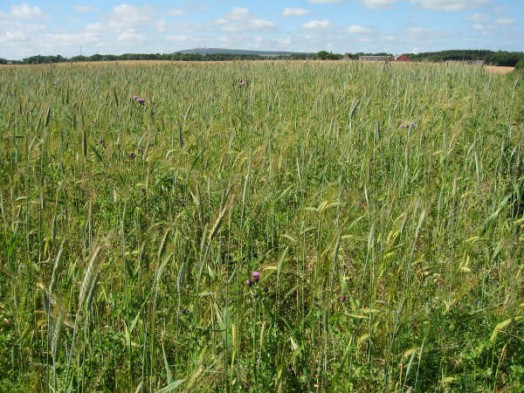
Well-established crop in summer with an abundance of grain – Credit: Hywel Maggs
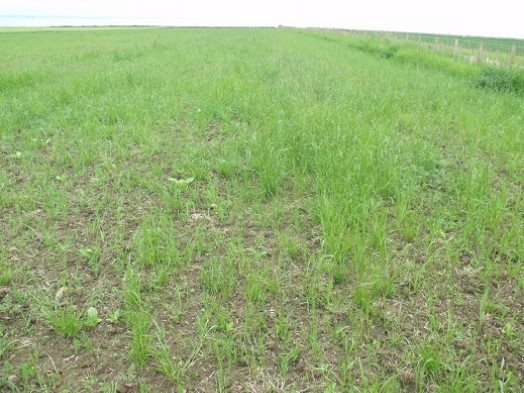
Poorly established crop in summer; sparse and with very little grain – Credit: Hywel Maggs
How to improve the success of this option
There are several ways in which you can increase the likely success of this option:
- aim to provide seed on at least two per cent of the agricultural area
- sow a number of strips or blocks around the farm rather than a single block of cover, with each block being a minimum of 0.5 hectares. This helps provide a plentiful supply of seed throughout the winter
- leave a cultivated, unsown three metre margin at the ends of wild bird crops to encourage arable plants
- combine this option with other options that also benefit seed eating birds and other farmland wildlife, including hedgerows, grass margins and beetle banks
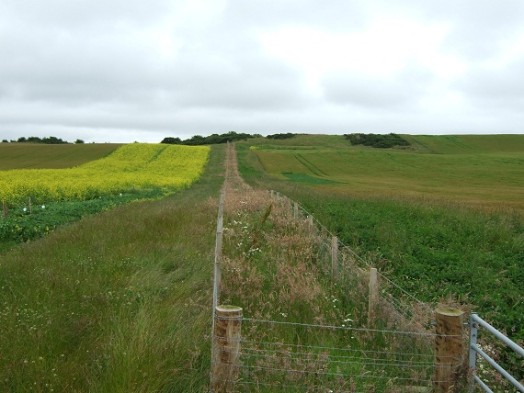
Strip of wild bird seed mix combined with field margin and hedgerow options – Credit: Hywel Maggs
What else benefits from this option?
In addition to seed eating birds, other species that will benefit from this option include mammals such as brown hares, voles and bats.
Including flowers in the mix, such as linseed, crimson clover and vetches, can also benefit insects. Not spraying the crop can increase numbers of other beneficial insects such as ladybirds, butterflies, moths and hoverflies.
Further information
More information on land management for a range of seed-eating birds visit the RSPB advisory pages. Individual advisory sheets are available for:
Further information on the benefits of wild bird seed mixtures and how to establish them is also available:
- Managing Arable Farmland for Wildlife (NatureScot)
- Game Crop Frequently Asked Questions (GWCT)
- Advice on Wild Bird Cover (RSPB)
- Arable Plants in Scotland – A Management Guide (Plantlife)
Recent changes
| Section | Change |
|---|---|
| Establishing the crop | Additional and edit to requirements added. |
| Further information | Name change from SNH to NatureScot. |
Previous versions
Download guidance
Click 'Download this page' to create a printable version of this guidance you can save or print out.
